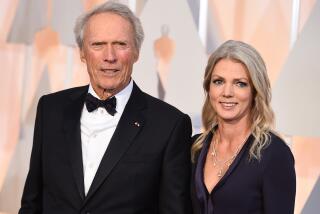Little Columbus Builds a Reputation
The first five names on the American Institute of Architects’ list of significant U.S. cities for innovation and design are hardly surprising: Chicago, New York, San Francisco, Boston and Washington, D.C.
It’s the sixth city that leaps out from the list: Columbus, Ind.
Not Columbus, the capital of Ohio, or Columbus, Ga., known for Ft. Benning. But the Columbus in Indiana, a town of 35,000 perched at the southern edge of the prairie 40 miles south of Indianapolis.
Since the 1940s, Columbus’ citizens have engaged in an extraordinary experiment in modern living, hiring the top international architects to design their public buildings and meld them into the fabric of their 19th century town.
More than 50 buildings represent an honor roll of modern architects: Eliel Saarinen and son Eero, I.M. Pei, Robert Venturi, Cesar Pelli and Paul Kennon. There are public schools by Edward Larrabee Barnes and Richard Meier; public housing projects by the team of Charles Gwathmey and Robert Siegel; banks by Kevin Roche, who created the master plan ensuring the continued development of the Metropolitan Museum of Art in New York, and postmodernist Harry Weese; and a public park by Michael Van Valkenburgh, a celebrated landscape architect and former department chairman at Harvard’s Graduate School of Design.
The town boasts six structures on the National Register of Historic Places and 600 well-loved 19th and early 20th century buildings in the historic district, a pastiche of Italianate, Greek and Colonial Revival, Queen Anne, Prairie and Shotgun styles.
Columbus is just 35 miles east of my hometown of Bloomington and close enough that over the decades I’ve cruised through the rumpled hills of southern Indiana many times to renew my wonderment with the town. I recently drove over for dinner and sauntered through the extraordinary downtown in the light of a brilliant spring moon.
As I neared Columbus, I perked up, knowing that I was close to something that’s unmatched in small-town America. The highway swooped through the Second Street Bridge’s dramatic red tethered pylons, and I knew I had arrived. Rambling through downtown, I felt as though I was in a living museum of architecture, a giddying walk through time.
The First Christian Church at 531 5th St., finished in 1942, was Columbus’ first foray into modernist architecture. It was designed by Eliel Saarinen, father of the International Movement, the bold modernist reaction to the endless decoration and frill of late Victorian architecture.
The church’s austere, elegant geometry is a striking counterpoint to the common Gothic and Georgian churches of the Midwest. The simple geometric box of limestone and pale buff brick wears a stone cross on its breast. Beside the massive sanctuary building, a 166-foot-high bell tower is a slender pencil box of brick reaching skyward--an elegant, wholly unsteeple-like expression of unalloyed piety.
Across the way, Pei, one the century’s acclaimed architects, designed the 1969 Cleo Rogers Memorial Library at 536 5th St., representing another era of modernism.
Saarinen’s church and Pei’s library cooperate to form a public area that feels like a gracious Umbrian piazza. It is an intimate cobbled space of proportions that would soothe an ancient Athenian, warm enough to make one linger for civilized discourse.
The plaza centers on sculptor Henry Moore’s bronze “Large Arch,” a primal paean to Stonehenge. (New York’s Museum of Modern Art has a small version. Columbus has the full-scale, 20-foot-tall, 5 1/2-ton piece.)
Columbus’ sleek post office at 450 Jackson St., designed by Kevin Roche, is strangely comforting, made with salt-glazed tile--normally seen on vintage silos--and mirrored glass. Maybe it is just the refraction of everyday Indiana life that makes it feel so homey; maybe it is the sheltering canopy that shades the busy sidewalk.
Nearby is the Commons, a black-glass-box shopping center designed by Cesar Pelli, the genius behind the Museum of Modern Art expansion in New York and the new terminal at Ronald Reagan Washington National Airport. The Columbus mall might be stark and modernist on the exterior, but inside beats the heart of Midwestern retailing: a Sears, a two-screen cinema and chain stores.
I watched kids caper under surrealist Jean Tinguely’s enormous “Chaos I” sculpture. The scavenged gears and levers and industrial detritus looped and turned and ceaselessly whirled in an incessant pattern of self-creation.
“Life is movement,” Tinguely said about his work. “Everything transforms itself, everything modifies itself ceaselessly, and to try to stop it . . . seems to me a mockery of the intensity of life.”
He might also have been speaking of Columbus.
Residents here are fond of saying they are different by design. This place is a cultural petri dish where the idea that good architecture can improve the human condition is still being tested with an almost naive faith.
In the 1950s, J. Irwin Miller, local doge and scion of Fortune 500 firm Cummins Engine Co., envisioned a program that would pay the design fees of internationally celebrated architects.
Yale- and Oxford-educated, Miller brought his refined aesthetic back to his hometown and supported it with his wealth and corporate power. Miller decided that community boards should choose the architects and oversee the design process.
Fire Chief Gary Burris told me about the design flaws of Robert Venturi and John Rauch’s award-winning Fire Station No. 4, a 1967 piece of modernist whimsy. It is a modest box of cinder block and brick, designed to meld into the surrounding neighborhood in an unprepossessing way, with the exception of a giant supergraphic “Fire Station 4” that tops the tall hose-drying tower.
The Columbus firemen used their experience to direct Boston-based William Rawn and Associates’ 1998 design of Fire Station No. 6, a postmodern structure with a curved roof that reminds me of Hoosier James Dean’s pompadour.
“We told them: ‘No flat roofs. And the windows have to open,’ ” Burris said. “Some of these architect-designed fire stations, they’ve got fixed windows with closed-loop heating and cooling, the same air endlessly recycled. Can you imagine what it’s like nine or 10 years later with 10 guys in there all the time?”
The Columbus Visitor Center, at 506 5th St., a two-story 1864 Italianate-styled brick house, is filled with illuminating exhibits. Glass sculptor Dale Chihuly’s bizarre “Yellow Neon Chandelier” hangs inside; its 900 pieces of hand-blown glass look like exotic and vaguely menacing seedpods.
A visitor center spokeswoman estimates a quarter-million people visit Columbus every year, although not necessarily for the architecture. But Columbus isn’t a tourist trap or a hothouse planned community with prescribed aesthetics and rigid sensibilities. It’s a real town with real people who have their share of quirky tastes and idiosyncratic ideas.
The furniture store that has Naugahyde BarcaLoungers in the window is neighbors with Eero Saarinen’s modernist open-plan masterpiece of the Irwin Union Bank branch office, which sounded the death knell for tellers’ cages. The airy accessibility of the Irwin tellers’ counters made the old-style, wrought-iron-and-marble booths look like intimidating barricades, as if the employees were paranoid.
Robert A.M. Stern designed the elegant Arts and Crafts-inspired Bartholomew County Hospital. (Stern is the architect behind Disney’s animation building in Burbank, the one with the giant “Sorcerer’s Apprentice” hat visible from the Ventura Freeway.) The hospital’s handsome, multistory brick building is reminiscent of classic Midwest banks or some of Frank Lloyd Wright’s early Oak Park work, well proportioned with exterior banding and fine detailing.
And at the edge of town, the North Christian Church’s hexagonal form erupts from the bermed earth with one dynamic pulse into a thin spire that plays the spinning heavens. Eero Saarinen, best known for his soaring, shimmering St. Louis Gateway Arch, designed the church, his last work. He said it was the building he wanted to tell St. Peter about.
Two generations have passed since this all started in Columbus. Both Saarinens, father and son, are long dead, and their stark modernist designs are old enough for National Historic designation.
Kevin Kennon of New York City’s Kohn Pederson Fox followed his father, Paul, to Columbus. His father was a beloved figure in town who designed numerous buildings as well as the master plan for the downtown street scape.
“I’ve been coming to Columbus since I was a boy,” Kevin Kennon said, “but I really appreciate it more since I’ve been coming with my team. What a humbling experience. Columbus is a unique mix of global and local outlooks, and there is a sense that people are always tinkering with their lives. It really is why you want to be an architect.”
Or an architecture fan, for that matter.
Douglas Wissing is a writer living in Bloomington, Ind.
(BEGIN TEXT OF INFOBOX / INFOGRAPHIC)
The Architects and Their Works Some notable architects and artists with works in Columbus, Ind. (listed alphabetically):
Richard Meier (1934-). American. Architect of the Getty Center in Los Angeles. In Columbus: Clifity Creek Elementary School.
Henry Moore (1898-1986). British. Works include 17-acre sculpture garden at Nelson-Atkins Museum of Art in Kansas City, Mo. In Columbus: “Large Arch.”
I.M. Pei (1917-). Chinese-born American. Designed Harvard’s John F. Kennedy Memorial Library in Dorchester, Mass.; East Building of National Gallery of Art in Washington, D.C.; new UCLA hospital. In Columbus: Cleo Rogers Memorial Library.
Cesar Pelli (1926-). Argentine-born American. Designed Carnegie Hall Tower in New York, Pacific Design Center in West Hollywood. Current project: expansion of Orange County Performing Arts Center in Costa Mesa. In Columbus: the Commons shopping center.
Kevin Roche (1922-). Irish-born American. Designed Ford Foundation headquarters and new Central Park Zoo in New York. In Columbus: Cummins Engine Co., post office.
Eero Saarinen (1910-1961). Finnish-born American. Designed the Gateway Arch in St. Louis and Dulles International Airport in suburban Washington. In Columbus: Irwin Union Bank & Trust Co. and North Christian Church.
Eliel Saarinen (1873-1950). Finnish. Designed the League of Nations building in Geneva. In Columbus: First Christian Church.
Robert Venturi (1925-). American. Designed Seattle Art Museum, Sainsbury Wing of National Gallery in London. In Columbus: Fire Station No. 4.
Harry Weese (1915-1998). American. Designed Washington’s Metro subway system and stations. In Columbus: First Baptist Church, Northside Middle School.
GUIDEBOOK
Making Your Way to a Modern Marvel
Getting there: From LAX to Indianapolis (40 miles north of Columbus), American Trans Air provides nonstop service; America West and Southwest provide direct service (one stop, no plane change); America West, American, Continental, Northwest, United and US Airways offer connecting service (change of planes). Restricted round-trip fares start at $198.
Getting around: Columbus Visitors Center (contact information below) offers bus tours daily from March through November. Cost: $9.50; discounts for seniors and students.
Where to stay: I didn’t stay overnight in Columbus, but I can recommend two places. The first is the Columbus Inn, 445 5th St., telephone and fax (812) 378-4289. Bed-and-breakfast operates in the former City Hall, an 1895 neo-Romanesque structure. Doubles range from $109 to $225.
Ruddick-Nugent Bed and Breakfast, 1210 16th St., tel. (812) 379-1354, fax (812) 379-1357, Internet https://www.ruddick-nugent-house.com. Offers four rooms in a sprawling 1884 Greek Revival mansion occupying a city block. Doubles are about $75.
Where to eat: Smith’s Row, 418 4th St., local tel. 373-9382. Considered Columbus’ best restaurant, it serves regional specialties such as breast of chicken Lexington served with a bourbon-mushroom sauce. Entrees range from $14.95 to $23.
Columbus Bar and Grill, 322 4th St., local tel. 372-5252. Friendly place in a building on the National Register of Historic Places. Pork tenderloin sandwiches come in two sizes, regular and giant (Frisbee-size).
Empire Tea Room, 445 5th St., local tel. 375-1937, Internet https://www.guystea.com. Authentic English tearoom at the Columbus Inn. Afternoon tea is $12, available noon to 6 p.m. Monday through Saturday.
For more information: Columbus Visitors Center, 506 5th St., Columbus, IN 47201; tel. (800) 468-6564 or (812) 378-2622, Internet https://www.columbus.in.us.
More to Read
The biggest entertainment stories
Get our big stories about Hollywood, film, television, music, arts, culture and more right in your inbox as soon as they publish.
You may occasionally receive promotional content from the Los Angeles Times.






